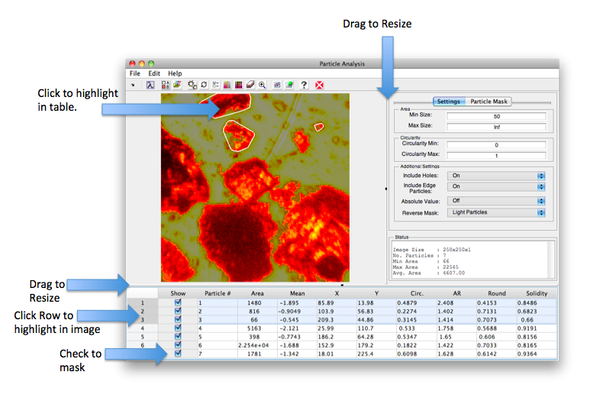Particle Analysis Window: Difference between revisions
imported>Scott |
imported>Scott |
||
| Line 34: | Line 34: | ||
* Check Box - Toggles all the selected particles. | * Check Box - Toggles all the selected particles. | ||
* Layers - Changes the background alpha color of the particles. Cycles through Black, White, and Red and can be used to enhance appearance of particles. | * Layers - Changes the background alpha color of the particles. Cycles through Black, White, and Red and can be used to enhance appearance of particles. | ||
* Zoom - Toggle zoom on and off. | |||
* Table Export - Export the particle table to [[analysis]]. | * Table Export - Export the particle table to [[analysis]]. | ||
* Image Export - Export the image to [[analysis]]. | * Image Export - Export the image to [[analysis]]. | ||
Revision as of 16:26, 24 February 2011
The Particle Analysis window is an interface into the analyzeparticles function. Included in the interface are controls for adjusting settings for the particle analysis and exploring the results. Once the particle analysis is complete you can export the resulting image and or table to analysis. When an image is exported to analysis, the particles identified by Particle Analysis are identified in class-sets associated with each particle. One classset has a class for each particle. Pixels within particle j have class = j. Non particle pixels have class = 0. Second classset has one class for all particles. Pixels within any particle have class = 1. Non particle pixels have class = 0.
Interface
The Particle Analysis interface has three main areas for the image, particle table, and analysis function settings. The basic workflow:
- Load image data.
- Adjust function settings.
- Run the particle analysis.
- Explore the results.
- Repeat steps 2-4 until you have the desired results.
- Save or export your results.
Menu
- File
- Load Workspace Image - Load image data (numeric or DataSet) from the Workspace.
- Import Image - Load an image from a supported file format.
- Save Image - Save image to file or workspace.
- Save Table Data - Save particle table data to file or workspace.
- Clear Data - Clear image and particle table.
- Close - Close Particle Analysis window without saving data.
- Edit
- Particle GUI Options - Optional settings for Particle Analysis interface.
- Particle Analysis Options - Optional settings for the Particle Analysis function. Note that most of these settings are available in the Settings area of the window.
- Help
- Particle Analysis Help - Opens this page.
- PLS_Toolbox Help - Opens main help page for PLS_Toolbox.
Toolbar
From left to right in the image above the toolbar buttons are:
- Lambda - Opens the Workspace Browser.
- Options - Open function options.
- Gears - Runs particle analysis using the current settings.
- Check Box - Toggles all the selected particles.
- Layers - Changes the background alpha color of the particles. Cycles through Black, White, and Red and can be used to enhance appearance of particles.
- Zoom - Toggle zoom on and off.
- Table Export - Export the particle table to analysis.
- Image Export - Export the image to analysis.
- Read X - Close the window without saving.
Settings
For a detailed explanation of the function setting see analyzeparticles. Additional settings can be found using Edit>Particle Analysis Options (or clicking the Options toolbar button).
Image
Depending on the settings, the image displays particles as regions masked with a semitransparent layer (alpha mask) either over each particle or over the non-particle region. The background color can be adjusted (using the toolbar button) to emphasize the regions.
Particle Table
The Particle Table has two particle selection methods. First, you can check/uncheck particles in the Show column. This will turn on/off the particle as show by the alpha mask. You can also select the "row header" (integer row number). This will draw an outline around the particle (see image above).
